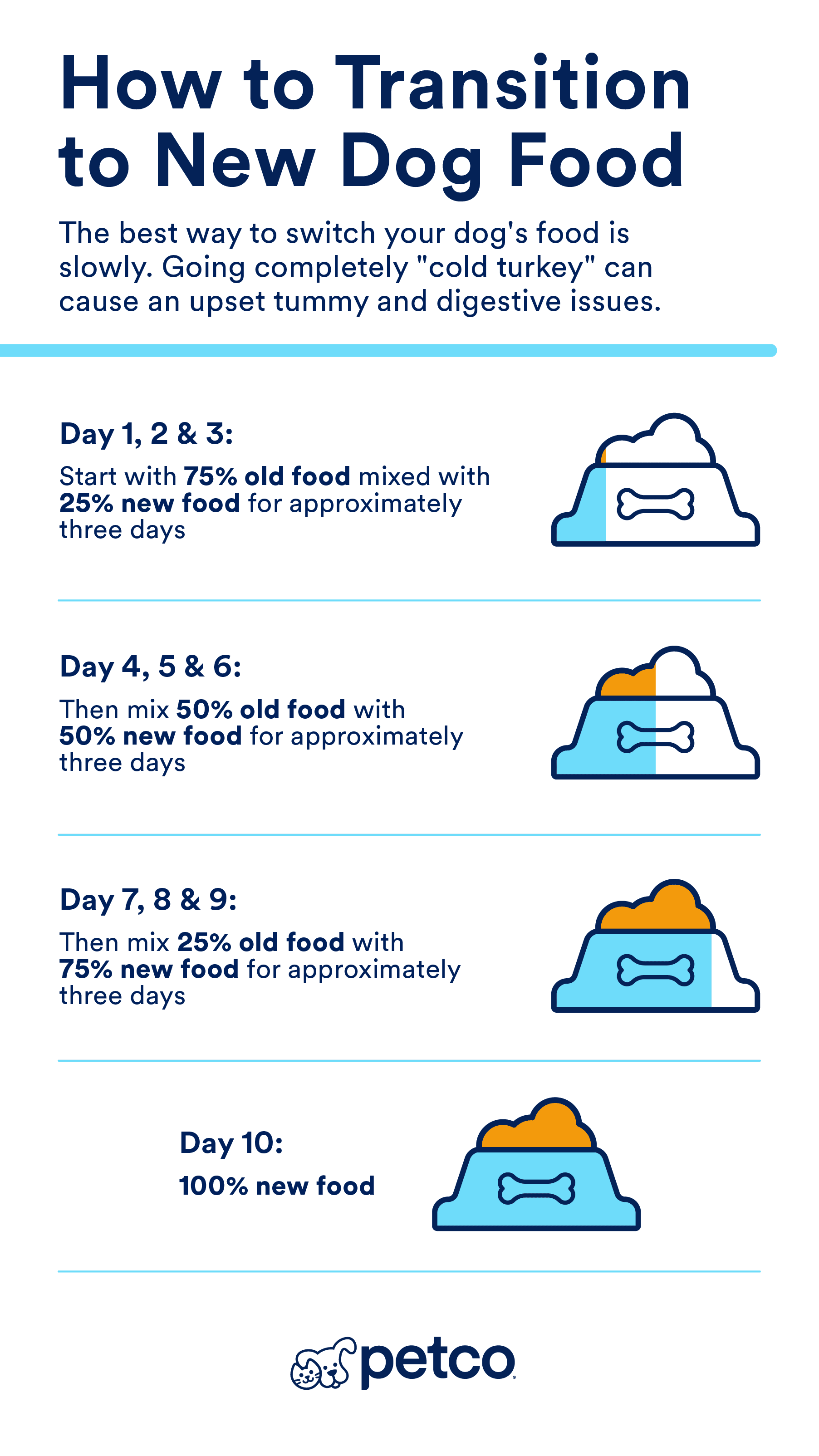How to Switch Your Dog's Food
Published On June 10th, 2025
Updated On June 9th, 2025

Reviewed By Petco’s Animal Care, Education and Compliance (ACE) Team
Education and Compliance (ACE) Team
There are many reasons you might find yourself changing dog food for your pup. The six most common reasons are below. And we’ve got details on each one!
You're bringing a new dog home and want to put them on a different formula
Your veterinarian has recommended a specific diet
Your pet has a food allergy or sensitivity
Your pet is entering a new life stage
Your pet needs to gain or lose weight
Better formula, price or availability
Changing your dog’s diet is a big deal because proper nutrition is one of the cornerstones for a healthy, happy dog. It’s always a good idea to consult with your veterinarian before getting started to ensure you are selecting the proper diet and amount of food.
How to transition between dog foods
Before detailing the different why's of changing dog food, let’s go over the how's. The best way to switch dog foods is sloooowwwwly. You do not want to completely switch without mixing them together or “going cold turkey.” This is for two reasons: One, switching a dog's food too fast could distrupt the familiar smells and flavors. Two, a sudden change in diet can trigger some symptoms: gastric distress, changes in bowel movements, and other signs of stress.

When changing dog food, do it slowly over a period of 7–10 days. The “recipe” is to combine the old food with the new food in staggered ratios.
Start with 75% old food mixed with 25% new food for approximately three days
Then mix 50% old with 50% new for approximately three days
Then 75% new, 25% old for approximately three days
Then 100% new
If your dog tends to have tummy issues, take your time and adjust the percentages to complete the change in 10-14 days. If it seems like your dog is reluctant to try the new food or seems to have any GI upset, that’s another reason to do the extended remix version of making the transition. If you don’t see improvement after a few days, reach out to your vet for guidance tailored to your fur baby.
Additionally, this gradual schedule can be used whether you are switching puppy food to an adult formula, going from wet to dry food or, really, any reason for the transition.
Why should I change my dog's diet?
The following are the most common reasons to introduce new food to your dog:
Bringing a new dog home
Congratulations! You have a new furry family member. Whether you have adopted a dog from a shelter or gotten a youngster from a breeder, that dog likely has an established diet they are used to. You might be eager to switch your new dog’s food as soon as you bring them home. Maybe you are loyal to a particular brand, or maybe you have other dogs and you want them on the same formula for convenience or you can't wait to spoil your new family member with the best food out there!. But moving to a new home and family, and maybe siblings, can be stressful. Keeping their diet consistent can help make the transition smoother. It’s a good idea to wait until after your dog’s first veterinary visit before changing their food. This gives your dog time to settle in and allows your veterinarian to check for any health issues that might require a specific diet. Which brings us to…
Your vet’s recommendation
Do you notice your Great Dane struggles to get up lately? Or your Poodle just got diagnosed with diabetes? There are diets tailored to various diseases or conditions, and your veterinarian may recommend a diet change for your dog to address that specific health need. Medical conditions with diets to support them include joint health, skin and coat issues, kidney disease, liver disease, heart disease, gastrointestinal issues, urinary disease, and canine cognitive dysfunction. Now, the transition schedule detailed above may not be appropriate in that case. As always, talk to your vet and get their recommended schedule anytime there is a health concern. There may be instances where a vet advises an immediate change if the benefits of the new food urgently outweigh the risks of a gradual transition.
Food allergies & sensitivities
Dogs have allergies and food sensitivities just like humans do, and they can be either environmental or food-related. The most common food allergies include beef, dairy, wheat, and chicken. What are the signs? Your dog might be extra itchy or have gastrointestinal issues – ugh! If you see hair loss or a lot of scratching or licking on the paws, ears, face, or anal area – that can be an allergy. Those gastro issues can manifest as vomiting, diarrhea, or excessive gas.
We are using the term “food allergy” but other sciencey terms your veterinarian may use are “food intolerance” or “adverse food reaction” instead of food allergy. There are different medical distinctions, but the outcome is the same – gotta try something else.
If you suspect your dog has a food allergy, you may need the assistance of a veterinary allergist or dermatologist. A special elimination diet may be necessary temporarily in order to pinpoint any allergens.
Then, you can choose the food that will be best for your pet, with the help of your veterinarian. Common formulas your vet may recommend include limited ingredients or “novel proteins.” That’s another sciencey term for “proteins not beef, chicken, or lamb.” These can include duck, trout, and even rabbit! Note: if your vet does have you eliminate chicken from the diet, make sure you also stop feeding any treats with chicken, as well.
From new puppy to new life stage
As puppies transition to adult dogs, their nutritional needs change, and a diet less rich in calories, protein and fat is appropriate.
To switch your puppy from wet food to kibble, start by gradually mixing dry kibble into their wet food over the course of 7–10 days. Slowly increase the amount of kibble while decreasing the wet food to help your puppy adjust to the new texture and flavor. Puppies can typically transition to an adult kibble formula around 12 months of age for small breeds and up to 24 months for large breeds. Since nutritional needs vary, it’s best to check with your veterinarian before making the switch.
On the other end of the age spectrum, dogs who reach the senior or geriatric stage of life also have unique needs thanks to a slower metabolism and older joints. (Dogs! They’re just like us!) Many senior formulas contain less calories and more antioxidants. On average, dogs are considered seniors between the ages of seven and 10. Giant breed dogs can be considered geriatric as early as six years of age.
Weight Management
While some causes of weight gain in dogs can be prevented (such as lack of exercise or overfeeding), others are sometimes unavoidable. Dogs that are older, less active, or spayed or neutered are more prone to experience weight gain. In some cases, you may choose to switch your dog to a weight management formula to help maintain a healthy weight. On the flip side, if your veterinarian determines your dog is underweight, there are special diets to help with that, too.
Better formulas, prices or availability
If you look at the dog food aisle or section of a website, it can seem like there are as many kinds of food as there are dogs! There are more types available today than ever before, including dry, wet, prescription, fresh and raw. You may decide you prefer refrigerated food over kibble, or kibble over wet food.
Another reason you may want to switch could be to improve the quality of food you offer your furry family member or to keep budget in mind as you make your selections. While promotions and coupons can be a big win, be mindful that your pet's tummy is sensitive and not equipped to handle frequent diet changes. We recommend picking a food that works best for your pet, your lifestyle and your budget long term.
Supply chain disruptions could also cause your dog’s usual food to become temporarily unavailable or even be discontinued. Additionally, the manufacturer of your dog’s regular food might issue a recall, making it necessary to find an alternative diet.
Summary:
Finally, some tools to help you determine success: When it comes to a diet, appearances are everything and a shiny, silky coat, with no dry skin, is a good sign. Something else to look for? Good stool. Yep, when switching to a new dog food, a highly effective way to determine digestive health is by looking at your dog’s stool. Expect some variations, of course, but significant changes could indicate significant issues. Did you know there’s a report card for poops? A great way to evaluate your dog’s stool is to use a Fecal Scoring Chart. An ideal fecal score is 3–4. Once you find a formula that your pet likes, it's a good idea to stay with it to avoid any of the above-mentioned issues. And trust us – your dog sticking with one formula isn’t punishment, it’s culinary consistency for his or her ongoing health and well-being!
Related Articles
Related Questions
Sponsored
Two Easy Ways to Start Earning Rewards!
Become a member today!Members-only pricing and offers, personalized care notifications, Vital Care points back on every purchase and more!Become a credit card member today!
Earn 2X Pals Rewards points at Petco
when you use Petco Pay!APPLY NOWLearn More About Petco Pay Benefits






